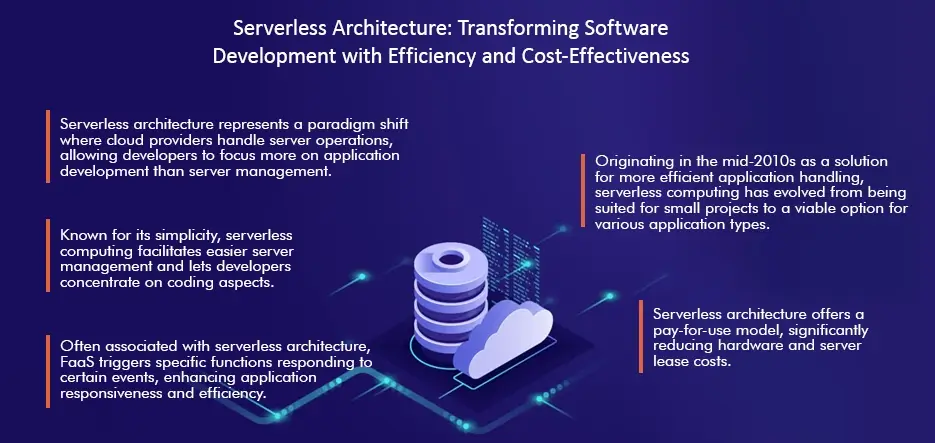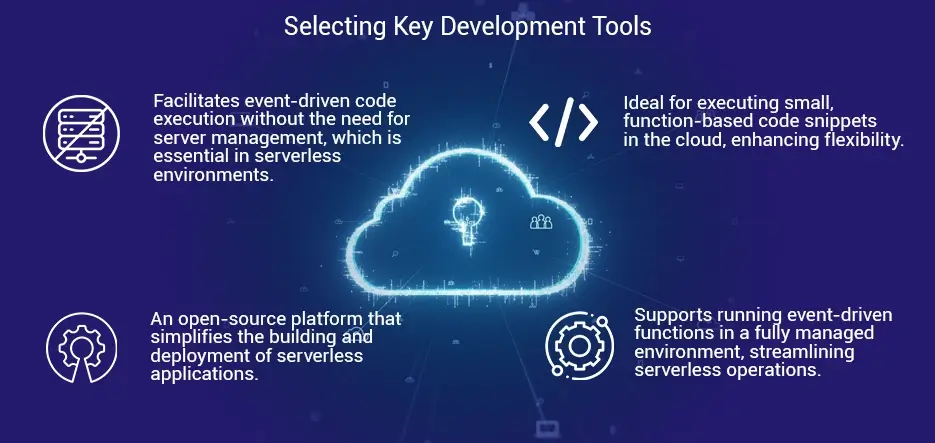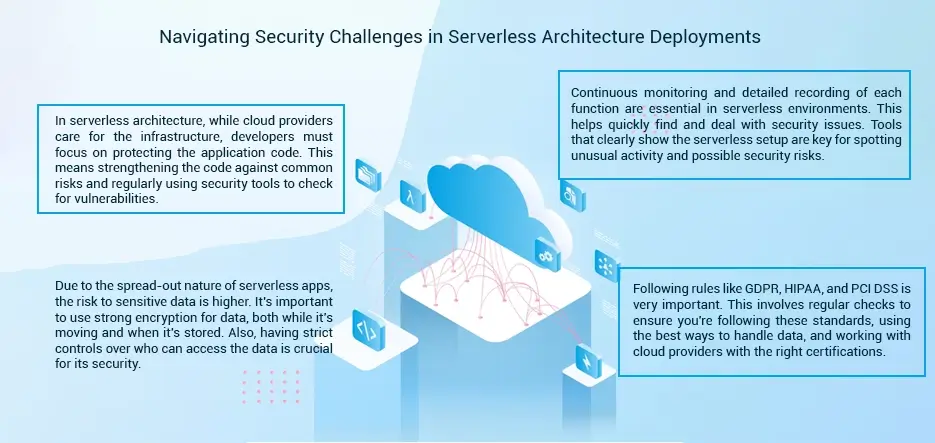Table of Contents
Serverless architecture marks a shift in software development. It’s a way where the cloud provider manages server operations. Developers use this to focus on creating and running applications, not on the servers. Although it’s called ‘serverless’, servers are used, but their management is the cloud provider’s job.
Serverless architecture is known for being simple and efficient. It makes server management easier, letting developers concentrate on coding. This style is often linked with ‘Function as a Service’ (FaaS), where certain events trigger specific functions.
This concept started in the mid-2010s as companies looked for better ways to handle applications. Before this, companies had to keep their servers or rent them. Both needed a lot of effort in management and planning.
Serverless computing brought a new way of using infrastructure. It lets businesses pay only for their resources, cutting down on hardware costs and server leases. At first, it was for smaller projects, but it grew as the technology improved.
Big cloud providers like AWS, Microsoft Azure, and Google Cloud made serverless more popular. They added new features and made it more reliable. Now, serverless is an option for many types of applications.
One of the key benefits of serverless architecture is its cost-effectiveness, highlighted by compelling statistics. AWS says using AWS Lambda can cut computing costs by up to 70%. Another study found a 51% quicker time to market with serverless tech. Also, a survey by the Cloud Native Computing Foundation showed that 53% of organizations using cloud tech, including serverless, saw better operational efficiency.
These points show how important and useful serverless architecture is in tech today. It helps reduce costs, makes things faster, and improves operations, making it a big part of the future of software development.

Understanding the Serverless Architecture
Core Components and Structure
Serverless architecture is a big change in cloud computing. It’s changing how apps are made, put out there, and looked after. Its main idea is to take the server part out of your hands, with cloud companies like AWS handling it.
The main parts of serverless usually are:
- Function as a Service (FaaS): These simple functions start when certain things happen. They are really important in serverless architecture.
- Backend as a Service (BaaS): These services that others handle and are part of serverless apps.
- Event-driven Architecture: This setup depends greatly on certain events that start and control the functions.
AWS Serverless Architecture is a great example. It has services like AWS Lambda that let you run code without handling the servers.
How It’s Different from Older Ways
Serverless architecture differs from the old way companies handled all the server stuff, like making them bigger or smaller, keeping them up to date, and fixing them. This old way needed a lot of work and sometimes meant you had too much or insufficient server space.
But with serverless, like what AWS offers, everything scales independently, is always available, and works based on events. This means your apps can adjust to how much they’re used without you having to handle the servers. This saves a lot of money and makes things run smoother, which is super important for businesses like healthcare digital transformation companies, where scaling and relying on your systems is key.
Serverless architecture isn’t just a new tech thing; it’s a new way of thinking in cloud computing. It’s more efficient, saves money, and scales better than old models, making it a popular choice in many fields.
Benefits of Serverless Architecture in Software Development
Scalability and Performance
Serverless architecture shines in its ability to scale and enhance performance. Unlike traditional server-reliant models, it lets apps adjust smoothly to changing workloads. Scalability is key in serverless computing. Cloud services like AWS, with AWS Lambda, enable apps to scale up or down automatically based on request volume. This means the system handles more work without extra help during busy times, and during slow times, it reduces resources, using them efficiently.
This adaptability leads to better performance. Serverless architectures quickly match demand, keeping app performance high, even with changing loads. This is great for custom software development companies in the USA, where app traffic can vary significantly.
Boosting Developer Work
Serverless architecture also greatly improves developer work. By removing server and infrastructure tasks, developers focus more on coding and less on operational issues. This is key in an industry where quick market entry matters.
In serverless settings, the cloud provider’s job is setting up servers, upkeep, and scaling. This lets developers spend more time creating features and refining the app, not managing infrastructure. For companies wanting to hire software developers, this means better use of developer time and quicker development cycles.
The positive effect of serverless on developer productivity is clear in industry surveys. The Cloud Native Computing Foundation found that developers reported a 33% productivity boost after moving to serverless architectures. This increase comes from simpler processes and more automation in serverless platforms.
Serverless is more than a tech advance; it’s a new approach to software development. Its scalability, performance, and productivity benefits make it an appealing choice for companies worldwide, from startups to big software development firms.
The 70% Cost Reduction Factors in Serverless Architecture
Reduced Infrastructure Costs
A big plus of serverless is how it cuts infrastructure costs. Traditional server setups usually need much money for hardware, software, and staff to run them. Serverless architecture, though, does away with the need for initial hardware spending and lowers costs for ongoing care and updates.
In serverless computing, the cloud provider handles the infrastructure. This leads to smarter use of resources. It’s especially good for custom enterprise software development and startups where budgets are tight. Cutting infrastructure costs without losing quality or performance is a big deal. It lets businesses use their money better.
A Contino report shows that going serverless can reduce infrastructure costs by up to 58%. This big saving comes from the pay-as-you-go approach that’s central to serverless.
The Pay-Per-Use Pricing Model
Serverless architecture’s pay-per-use pricing is another key to its cost savings. Unlike old models, where you pay for server space whether you use it or not, serverless computing charges are based on usage. This means you only pay for the computing power you use. This makes running things more cost-effective.
This model is great for custom software development for startups. It helps startups manage their budget better, avoiding the costs of keeping server space they don’t use. As serverless architecture automatically adjusts to demand, startups only pay for what they need at any time.
Detailed Comparison Between Traditional Development Approaches and Serverless Architecture
| Aspect | Traditional On-Premise Hosting | Serverless Architecture |
|---|---|---|
| Security | Highly secure with on-site servers inaccessible to unauthorized individuals, yet breaches can occur, leading to significant data losses. | Operated by cloud providers, increasing the potential for breaches, but advanced encryption and security protocols help maintain safety. |
| Cost | Significant expenses associated with hardware, installation, maintenance, energy consumption, and staffing. | Reduces costs by 70-90% due to no need for hardware purchases, redundant services, or additional staffing. |
| Control | Complete control over operations with visibility and management conducted internally. | Relinquishes some control to the cloud provider, although retains oversight. |
| Support | In-house IT teams deal with server issues, risking prolonged downtime if unresolved. | Cloud provider’s responsibility to manage and swiftly resolve issues, benefiting from their extensive problem-solving expertise. |
| Scalability | Scaling requires substantial investment in time and resources for new hardware setups, putting on-premise solutions at a disadvantage. | Offers solutions that adapt on-demand, with the ability to instantly adjust resources as needed. |
| Accessibility | Direct access to data without needing the internet is beneficial in areas with unstable internet connections. | Dependency on internet access means potential loss of data access during outages, risking business operations. |
How Serverless Architecture Utilizes Resources for Cost Reduction
Efficient Resource Allocation
Serverless architecture is revolutionizing cloud computing with its smart use of resources. It differs from traditional server-based systems because it allocates resources based on the app’s current needs. In serverless setups, resources aren’t tied to one app. Instead, they are shared across many apps as needed. This way, resources are used fully, without waste.
For enterprise custom software development companies, this means using cloud resources more effectively and cheaply. Serverless lets these companies run apps without worrying about having too much or too little server space.
Automatic Scaling and Balancing
Serverless architecture also does scaling and load balancing automatically. Platforms like AWS or Azure adjust computing resources to match the app’s needs. This auto-scaling ensures apps work well and respond quickly, no matter how many users or how much use there is at any time.
For firms offering digital transformation services, being able to scale and balance automatically is super valuable. It lets them handle different amounts of work easily, ensuring their apps are always running well without needing someone to watch over them.
Serverless is changing how we use resources in cloud computing. It offers a more streamlined, cost-saving approach. Its effects on enterprise software development and digital transformation services are big, giving these areas more efficiency and flexibility.
Tools and Practices for Maximizing Efficiency in Serverless Architecture
Key Development Tools
In serverless architecture, choosing the right development tools is vital for efficiency. These tools help smooth the development process, from writing code to launching it. For firms focusing on custom software development consulting, these tools are key to making strong serverless solutions.

Important tools include:
- AWS Lambda: This lets developers run code based on events without managing servers.
- Serverless Framework: An open-source tool that helps build and launch serverless apps easily.
- Microsoft Azure Functions: Good for running small code snippets, or functions, in the cloud.
- Google Cloud Functions: This tool runs event-driven functions in a managed environment.
Best Development and Launch Practices
Following some best practices is crucial to get the most out of serverless. These are even more important when using artificial intelligence in software development, where efficient, scalable solutions are necessary.
- Modular Design: Making apps modularly means changes in one part don’t affect the rest.
- Event-Driven Processes: Using event-driven processes helps manage how serverless functions run.
- Continuous Integration and Deployment (CI/CD): CI/CD pipelines ensure updates are smoothly and regularly added to the live app.
In serverless architecture, being efficient is crucial. Businesses can use serverless tech by picking the right tools and sticking to best practices. This leads to more creative and scalable solutions in software development.
Best Practices for Continuous Cost Monitoring in Serverless Projects
Budgeting and Cost Analysis Techniques
In serverless architecture, especially for custom software development outsourcing, keeping a close watch on budgeting and cost analysis is vital. Serverless pricing models are unique, focusing more on how often and in what way functions are used rather than on traditional measures like compute and storage use.
Effective cost management in serverless projects involves:
- Accurate Estimation: Predict the expected number of function uses, memory, and network needs to foresee costs.
- Cost Allocation Tags: Use tags to sort expenses by project, department, or type of use for better cost tracking and analysis.
In agile software development life cycles, including cost analysis in each phase helps constantly check serverless use, ensuring projects stay on budget.
Tools for Cost Monitoring and Optimization
There are tools to monitor and lower costs in serverless setups. These tools show where and how resources are used and determine where to save money.
Important tools are:
- AWS Cost Explorer and Budgets: These offer insights into AWS Lambda use and costs for detailed tracking and budgeting.
- Azure Cost Management + Billing: This tool is great for managing the costs of Azure serverless functions.
- Google Cloud Cost Management: Provides detailed reports for Google Cloud serverless services.
Companies that outsource custom software development and use serverless can use these tools to watch usage patterns, find inefficient functions, and cut costs. Applying these best practices for ongoing cost monitoring in serverless projects is crucial. They help businesses fully use serverless architecture while keeping control over their spending, a key factor in today’s fast-changing tech world.
Selecting the Right Serverless Architecture Development Services
Picking the right serverless development services is key, especially for U.S. businesses in custom software development. The choice should be careful, looking at different things to ensure the service fits the business needs.
Things to consider include:
- Expertise and Experience: Find providers with solid experience in serverless architecture. Having worked in your industry or on similar projects is a big plus.
- Scalable Services: The provider should be able to handle your business growing or changing.
- Security and Compliance: Make sure they follow standard security rules and meet any special requirements you have.
How to Evaluate Providers
After you know what you need, look closely at what each serverless service offers. This includes:
- Checking Their Tech Skills: Make sure they know serverless technology.
- Looking at What Other Customers Say: Feedback and success stories tell you a lot about how reliable and good the provider is.
- Understanding Their Prices: The cost should fit your budget and what you expect to pay.
For custom software development services in the USA, choosing a serverless provider is a big decision affecting your projects’ performance. MarketsandMarkets says the serverless architecture market is growing a lot, which means more and more companies want these services.
When picking serverless development services, think about their skills, how they can grow with you, their security, and how much they cost. This helps you find a partner who meets your needs and helps your business succeed digitally.
Analyzing the Environmental Impact of Serverless Architecture
Serverless architecture is changing the tech world and helping the environment. This move to eco-friendly tech is very important in areas like digital transformation in healthcare. Here, it’s as vital to reduce carbon emissions as it is to advance technologically.
Serverless computing uses resources smartly. Unlike traditional servers that often waste energy by running when not fully used, serverless systems use power only as needed. This leads to more efficient energy use.
A big environmental plus of serverless is the need for fewer physical servers. Traditional data centers use much energy to keep servers running, including cooling and backup power. Serverless computing uses centralized cloud data centers, which need fewer physical servers. This means using less energy and fewer greenhouse gases.
Cloud providers with serverless work hard to make their data centers use less energy. They’re using renewable energy, better cooling tech, and making servers work more efficiently. This is important in fields like digital transformation in healthcare, where the need for computing keeps growing.
Serverless architecture is great for the environment, but it’s not perfect. One issue is that it might cause more network traffic, as serverless apps often use many cloud services. This could indirectly use more energy. But, as tech gets better, more efficient networking is being developed.
The future looks good for serverless from an environmental standpoint. As more companies choose serverless and cloud providers keep improving energy efficiency, the tech industry should see a drop in its carbon footprint. This is especially key in healthcare, where balancing tech progress and environmental care is crucial.
Integration of Serverless Architecture with Emerging Technologies
Combining serverless with artificial intelligence development (AI) and machine learning (ML) is changing how companies handle data and make decisions. Serverless platforms offer the scalability and flexibility AI and ML need. They often require lots of computing power. With serverless, companies can run these advanced algorithms well, paying only for their computing.
In the Internet of Things (IoT) world, serverless architecture is key. IoT devices create huge amounts of data. Serverless computing offers a way to handle and study this data in real-time. With serverless, IoT apps can adjust quickly to changing data, which is important for everything from smart homes to industrial IoT.
Blockchain tech is another area where serverless helps. Adding serverless to blockchain apps lets companies handle changing workloads better. This is good for apps with varying transaction levels, as serverless can match resources to needs.
Edge computing processes data near its source. Serverless is useful here, too. It provides a flexible, scalable way to handle data at the edge. This is great when you need fast responses and real-time processing.
Serverless architecture’s role with new technologies is set to grow. As these technologies advance, serverless solutions will be key for being scalable, efficient, and cost-friendly. This isn’t just about tech. It’s a step towards more creative and responsive digital environments.
Security Considerations in Serverless Architecture Deployment
When you use serverless, knowing its unique security issues is important. Serverless computing has many benefits but also brings special security challenges. In serverless, cloud providers look after the infrastructure’s security. But, securing the app code is up to the developers.

A big security focus in serverless is on the app itself. This means ensuring the code is safe, handling third-party parts well, and protecting against hacking or data leaks. Developers need to make their code strong against common risks. Regular updates and using security tools to check for weak spots are key.
Data protection is also crucial. In serverless, sensitive data can be more at risk because the apps are spread out. Using strong encryption, both for data moving around and stored, and strict access control are needed to keep data safe. This means setting up good ways to check who can see the data and when.
Always watching and recording what happens is essential in serverless. You need to focus on each function in serverless. Good recording and instant monitoring help quickly spot and handle security problems. Tools that let you see the serverless setup can alert you to odd patterns or possible security issues.
Serverless setups also need to follow laws and standards. This includes GDPR for personal data, HIPAA for health info, and PCI DSS for payment data. Staying compliant means regular checks, following data handling best practices, and sometimes working with cloud providers who are certified.
As serverless architecture keeps changing, it’s important to stay ahead of new security threats. Future trends could be better AI for security and more advanced threat-spotting systems. Keeping up with the latest security and updating your strategies is crucial to keeping your serverless safe.
Evaluating the Total Cost of Ownership in Serverless Architecture
In serverless architecture, knowing the Total Cost of Ownership (TCO) is key for businesses to decide wisely. TCO in serverless isn’t just about saving on servers. It covers a lot, like developing, deploying, managing, and scaling apps.
Several things influence serverless TCO:
- Operational Costs: This is about the money spent on deploying, watching, and keeping up serverless apps. Even though serverless cuts down on physical server care, it might add costs for advanced deployment and monitoring tools.
- Development Costs: Serverless can lower the time and money spent on development because it’s simple and easy. But, developers might need to learn new ways and practices for serverless.
- Scaling Costs: Serverless architecture’s big plus is how well it scales. Scaling serverless apps can cost less than traditional ones, as resources are used better, and you pay per use.
- Hidden Costs: This includes networking, data moving, and storing costs, which can be missed in serverless. Knowing these hidden costs is crucial for a full TCO picture.
To compare serverless TCO with traditional server setups, you must look at more than just upfront costs. Even if starting with serverless seems pricier due to migration and learning costs, long-term savings on infrastructure and running things more smoothly often make up for it.
There are tools and methods to help figure out serverless TCO. These tools look at all costs, not just direct ones but indirect ones, like how productive developers are and how efficient operations are.
To understand serverless TCO, you must think about direct and indirect costs. By looking at all these, businesses can make smart choices about going serverless and making the most of their cloud computing investments.
Strategies for Optimizing Performance in Serverless Architecture
In serverless architecture, how well your code works matters. Writing clear, efficient, and simple code is key. This means using fewer unnecessary parts, which can slow down how fast functions run. Developers should aim for code that does specific tasks well and quickly.
Caching is a great way to make serverless architecture work better. Caching can reduce the delay in getting data from databases or external APIs. By keeping often-used data in a cache, serverless functions can get to this data faster, improving response times.
Reducing the cold start time – the time it takes for a serverless function to start – is important. To shorten cold starts, keep the function small, avoid big frameworks, and use warm-up scripts that keep the functions ready.
API gateways are really important in a serverless. They’re the first stop for serverless functions and can be tuned for better performance. This means setting up efficient paths, making sure the load is balanced, and using rate limits to avoid using too many resources.
Keeping an eye on how things are running is key. This means checking how long it takes to run, memory usage, and error rates. Tools from cloud services and other monitoring tools can give deep insights into performance and show where to make improvements.
When making serverless architecture work better, think about how much it costs. Finding the right balance between making things run better and what it costs is important for a serverless setup that works well and doesn’t cost too much.
To make serverless perform its best, focus on coding well, using caching, speeding up startups, and making the most of API gateways. Keeping track of performance and balancing costs and benefits can improve how serverless systems work.
Conclusion
Serverless architecture is a big leap in cloud computing. It brings many benefits that change how businesses develop and deploy software. Key points are:
- Cost-Effective: With serverless, you only pay for what you use. This saves a lot of money.
- Scalable: Serverless can handle changes in workload smoothly, keeping performance steady.
- Boosts Developer Work: Developers don’t have to worry about server issues. They can focus on creating great software.
Serverless is more than just a trend. It’s changing how IT works, making building and running applications more agile and cost-effective.
Looking forward, serverless architecture is likely to grow and be used more. It fits well with what modern, fast-moving businesses need. We expect it to join new tech like artificial intelligence and machine learning. This will open new doors for being creative and efficient.
As serverless improves, we’ll see stronger security, easier-to-use interfaces, and more use in different industries. For businesses thinking about going serverless, things look good. It offers a way to be more agile, save money, and be innovative in software development.
Now’s the time to check out what serverless can do with A3Logics. Whether you’re a startup wanting to build flexible apps or a big company looking to update your IT, serverless is a solid choice that keeps up with the digital world’s changes.
FAQs
What is Serverless Architecture, and How Does It Work?
Serverless architecture is a cloud computing method where the cloud provider manages the machine resources dynamically. Even though it’s called ‘serverless’, servers are still involved, but developers don’t manage them. Instead, they write and deploy code, and the cloud provider looks after running, scaling, and managing the infrastructure. This setup lets apps be split into smaller, event-driven pieces that can be scaled and maintained independently.
How Does Serverless Save Money in Development?
Serverless architecture mainly saves money through its pay-as-you-go pricing and less need for infrastructure management. Businesses only pay for resources when their functions are running. This cuts out the cost of keeping server space that’s not being used. Also, since the cloud provider manages the infrastructure, there’s a big drop in server care costs and scaling costs.
Main Differences Between Traditional and Serverless Architectures?
The big differences are in scalability, cost, and who handles operations. Traditional setups need servers set up in advance, which might not always match the need. Serverless scales automatically to match app demand. Cost-wise, traditional means fixed costs, while serverless is pay-for-what-you-use. Operationally, serverless takes the server management load off developers.
Can Serverless Handle Big Apps?
Yes, serverless is great for large apps because it scales automatically and efficiently handles many requests. Big apps work well with serverless because different parts of the app can grow or shrink in size as needed.
How is Billing Done in Serverless?
Billing in serverless is based on actual use, not pre-bought capacity. This includes how often functions are run, how long they run (usually measured in milliseconds), and how much memory is used. This way, costs match up directly with how active the app is.






